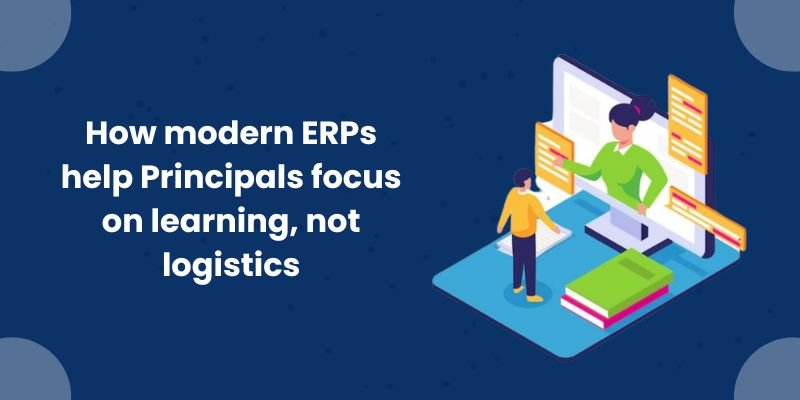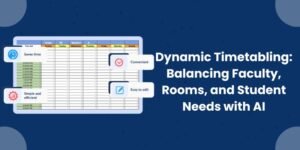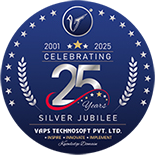In today’s fast-paced education landscape, the role of a school principal is more complex than ever before. Beyond being academic leaders, Principals are expected to be administrators, counsellors, communicators, data analysts, and sometimes even troubleshooters. With so many hats to wear, one critical aspect often ends up taking a backseat: learning.
While principals aim to create impactful learning environments, much of their time is consumed by paperwork, processes, and people management. That’s where modern Enterprise Resource Planning (ERP) systems can make a transformative difference — by streamlining operations so Principals can focus on pedagogy, not paperwork.
The Logistics Trap
Traditionally, running a school meant juggling a multitude of logistical challenges:
- Tracking attendance and managing absenteeism
- Coordinating staff schedules and managing substitutions
- Communicating with parents across various platforms
- Handling admissions, fees, compliance, and reports
- Ensuring exam schedules, invigilation, and result compilation
- Responding to emergencies and ad hoc issues
These tasks are important, but they often distract school leaders from strategic planning and instructional leadership. When a Principal is busy chasing fee defaulters or figuring out transport routes, valuable time is lost — time that could have been spent mentoring teachers, designing enrichment programs, or reviewing student performance.
Enter the Modern ERP: More Than Just Software
Modern education ERPs are not just tools for digitization. They are platforms for transformation.
A modern ERP is a centralized, cloud-based platform that integrates various school functions — academic, financial, administrative, and communicative — into a single, cohesive system.
Think of it as the school’s digital nervous system.
Whether it’s generating report cards, managing staff attendance, sharing circulars, or tracking transport, a well-designed ERP allows these processes to happen in real time, with minimal manual intervention.
And this automation brings a game-changing benefit: time and focus.
An integrated ERP system brings all school operations — academic, administrative, financial, and communication — under one digital umbrella. This unified approach eliminates redundancy, increases transparency, and provides real-time insights into every aspect of school functioning.
Key features include:
- Automated Attendance Tracking
- Digital Timetable & Substitution Management
- Fee Collection and Accounting Integration
- Online Admissions and Record Keeping
- Exam Scheduling & Grade Management
- Parent-Teacher Communication Modules
- Staff Performance Dashboards
- Inventory & Asset Management
Reclaiming Time for What Matters
The biggest advantage? Time.
Modern ERPs free up Principals from low-value, high-effort tasks. Here’s how:
1. Automated Administrative Processes
Tasks that once took hours — like generating fee defaulter reports or collating attendance — can now be done in seconds. This reduces stress and increases accuracy.
2. Centralized Communication
ERPs streamline communication with parents, staff, and students. Notifications, circulars, meeting invites — all go out from one platform, minimizing confusion and increasing engagement.
3. Data-Driven Decision Making
Instead of sifting through files or Excel sheets, Principals get intuitive dashboards with academic insights, teacher performance data, and student trends — helping them make timely, evidence-based interventions.
4. Compliance Made Easy
With built-in documentation, reporting templates, and audit trails, regulatory compliance becomes simpler and more transparent.
From Admin Head to Learning Leader
An ERP doesn’t just make a Principal’s life easier — it elevates their role.
Instead of functioning as an operations manager bogged down by daily crises, the Principal becomes a true leader — someone who shapes curriculum, builds teacher capacity, fosters student well-being, and steers the school toward excellence.
This shift isn’t just good for the Principal. It’s transformational for the entire school community.
When ERPs take care of logistics, Principals can shift their focus to what truly defines school success: student learning outcomes.
This means:
- Observing classrooms and supporting teacher development
- Engaging with students meaningfully
- Setting academic goals and tracking progress
- Encouraging innovation in pedagogy
- Building partnerships with parents and communities
- Leading with vision instead of reaction
In essence, ERPs help Principals move from firefighting mode to strategic leadership mode.
The Human Touch, Powered by Technology
Critics often argue that technology can make education impersonal. But the truth is: when used right, tech gives educators more space to be human.
With less time spent on operations, school leaders can invest more in relationships — with teachers, students, and parents. And that’s where transformation begins.
A great ERP doesn’t just help schools run better; it helps them teach better.
In an age where expectations from schools are higher than ever — academic excellence, social-emotional learning, digital literacy, safety, and more — we must give Principals the tools to lead effectively.
Modern ERPs aren’t a luxury. They’re a necessity.
Because when logistics are automated, learning becomes the priority — and isn’t that the goal of every good school?












